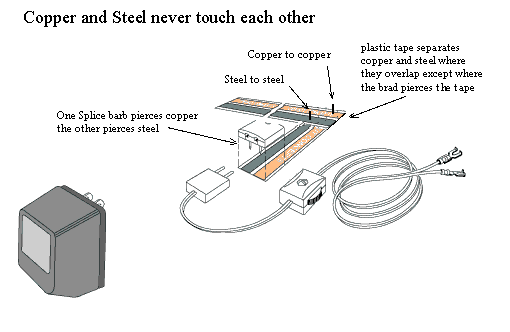
A transformer's output is measured in "Volts" and "Amps"
Volts: electrical pressure (see "Power Basics"). Dollhouse lights are sized to run at 12v so any transformer that is hooked to a dollhouse must deliver 12v of power. Look on the transformer's info tag - it will say "Output: 12v" or "12VAC", or "12VDC" (see below). As I look through my drawer of leftover transformers, I find several transformers that are rated 3.7V (from cell phones past), many that are rated 9v (they would hardly make a dollhouse lightbulb glimmer), and one rated 32v (from a computer printer). But I did find one 12v transformer.
The information tag says
"PLUG-IN CLASS 2 TRANSFORMER " (this is suitable for dollhouse wiring)
"INPUT: 120V 60Hz 20W" (this means it will run on North American household wiring)
"OUTPUT: 12VAC 1300mA" (this means it delivers 1300 milliamps = 1.3 Amps)
This transformer would work to run some dollhouse lights... but how many?
Amps: Amps is a measure of electrical volume (see "Power Basics"). In dollhouse wiring, amps is the rating that tells you how many lights you can power with your transformer.
12V "Grain of wheat": 60milliamps
16V "Grain of wheat": 45milliamps
(this will run on a 12v circuit with a little less brightness)
12V "Grain of rice": 50
milliamps
16V "Grain of rice": 35 milliamps (a little less brightness also means lots longer life)
1.5V "Micro": 15 milliamps
My 1300mA transformer could power (21) 12V "grain of wheat" bulbs (1300/60 = 21.66) or (38) 35 milliamp bulbs... sounds respectable! These are the bulbs used in most simple fixtures.
Micro bulbs are used in chains (in electricity, it's called "series") where they are strung together in a line and their resistance to the supplied voltage is added together... so (4 to 6) 3V bulbs in series or (8 to 10) 1.5V bulbs in series can be used on a 12V source. Series wiring is the "one bulb goes out - they all go out!" style that was used in Christmas tree strings for years. You will find this bulb in some chandeliers and in dollhouse Christmas tree strings. When this kind of load is used you must add 15 milliamps for each bulb. Some chandeliers draw 150 milliamps.
My 1300 milliamp transformer in a house that plans to use 3 chandeliers might only have 12 single bulbs of left over capacity - now I can see that there is a limit.
This transformer would be adequate for a small to medium house, but not big enough for a grand mansion!




Short Circuit: Your very best protection from the damage caused by a short circuit is a transformer with a circuit-breaker. This can save you many hours of tearing your dollhouse apart to find the hidden break in the circuit. I recommend dollhouses always be protected with curcuit breakers
Sizing Transformers: Transformers are most often rated in "Watts". To translate watts into milliamps first calculate "Amps" (milliamps / 1000) using the formula: Amps=Watts/Volts (A=W/V), then multiply by 1000 to get milliAmps... for 12 volt systems, a 20 watt transformer would deliver
Amps=20watts/12volts=1.66 Amps =1660 mA, enough for (27) 60mA bulbs or (41) 40mA bulbs
Now add up the milliamp rating for all the bulbs you anticipate using and compare the result to the milliamp rating for the transformers
1 watt = 83 milliamps = (1) 60 milliamp lightbulbs or (2) 35 milliamp bulbs
10 watts = 830 milliamps = (13) 60 milliamp bulbs or (21) 40 milliamp bulbs
40 watts = 3300 milliamps = (55) 60 milliamp bulbs or (82) 40 milliamp bulbs
If you need to go larger than that, wire the house with two or more unconnected circuits, and power each with its own transformer. Here's a diagram for a Queen Anne with 3 zones